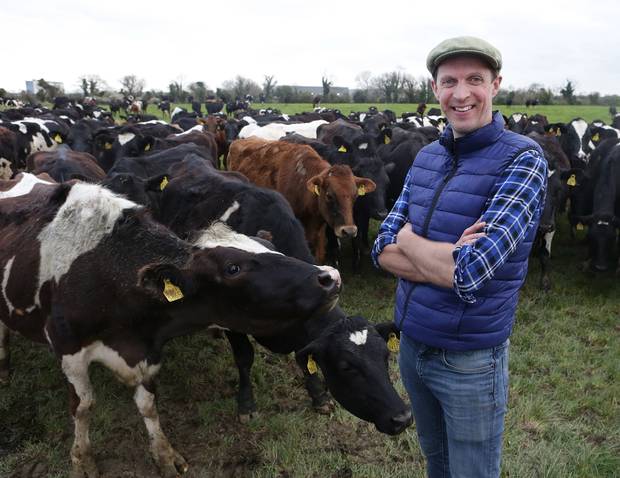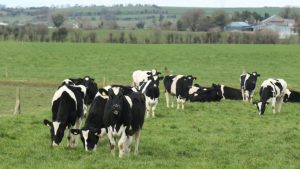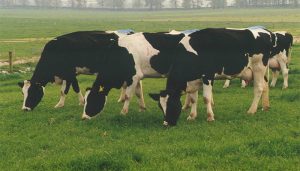
I’ve been writing for years about the biological timebomb that is our useless Jersey bull calves.
But it’s also entirely understandable for dairy farmers to breed their cows for the most profitable replacement.
Reliable research puts the annual benefit of crossing Jersey and Friesians at nearly €17,000 in a 100-cow herd.
The hybrid vigour that results from the outcross of unrelated genetics gives the crossbred cow a major fertility boost, which is crucial in the unforgiving world of spring-calving milk production.
If a cow isn’t fertile enough to go back in calf within the 12-week breeding period that follows every calving season, she misses the three-month spring window when the farmer can marry fresh-calved cows’ feed requirements with the explosion in spring grass growth.
Any speed-wobble in conditions from calving to breeding puts the cow herself under massive pressure to maintain enough energy to simultaneously produce milk and go back in-calf.
The crossbred cow excels in these conditions not only because of her inherently higher fertility, but her smaller size than traditional Friesians means she actually needs less energy to keep the wheels turning.
In short, with nature’s challenges of grass shortages, disease pressures, or cold weather, it’s the crossbred cow that’s less likely to end up in burgers by the end of the season.
The icing on the cake for the dairy farmer is that the Jersey-Friesian crossbred is the perfect marriage of big milk volumes from the Friesian genes with high protein and butterfat concentrations from the Jersey side.
But the smaller frame that is so crucial for fertility is also the Achilles heel in this equation.
The male bull calves are next to useless, as confirmed by Teagasc’s warning to beef farmers late last year that they would make less than €100 per head from fattening Jersey crossbreds even if they got them for free.
When an industry places no value on an animal, all kinds of scary problems arise.
The farmers producing them have no economic incentive to mind them, which often results in higher mortality rates.
In many cases, the most humane solution for Jersey crossbred bull calves is to put them down at birth.
But farmers hate doing this, so they pass the job on to a bobby-calf slaughter facility.
Presumably Teagasc were mulling over this horrible vista and concluding that we have no hope of building a premium-brand dairy industry if this reality becomes the norm.
So why hasn’t something been done about this before now?
Follow the money, baby.
Sexed semen promised to be the silver bullet for this issue, where a farmer could chose to impregnate the cow with specially sorted semen to produce either a female calf sired by a dairy bull or a male calf sired by a beef bull.
However, a series of national trials here have delivered disappointing results.
Lower conception rates with sexed semen means it costs the dairy farmer more to get his cow in calf to sexed semen than conventional. More importantly, anything that compromises the re-breeding of a dairy cow in that crucial three-month window starting this month is just not going to be considered by the hardcore commercial operators.
However, this spring there was a pincer movement that has forced the industry to try harder to solve this issue.
The collapse in prices for dairy calves was an obvious problem, but equally noticeable is the increasing criticism of dairy’s growth from all sides.
The environmentalists are decrying the impact of the sector’s expansion on emissions; vegans claim that every dairy animal is subjected to a life of misery; and beef farmers accuse dairy men of gobbling up land and flooding the beef market with poor-quality cattle.
Some dairy farmers will claim that the benefits of cross-breeding outweigh any fall in value of the beef calf, even if those calves become a net cost to remove from the system.
But I think that the bigger picture of a dairy industry producing hundreds of thousands of worthless bull calves that end up being euthanised is a terrible gamble for a sector that is profitable enough to be able to invest in better solutions.
Equally, if dairy farmers expect beef farmers to fatten up to a million calves from the dairy herd every year, then they need to accept that the buyer of those calves can make a twist on them.
The ICBF’s new Dairy-beef index is a partial solution but it doesn’t tackle the dairy farmer’s impetus to breed profitable replacements.
Without eliminating dairy bull calves by using technologies like sexed semen, the core problem of useless bull calves remains.
Taking the lead by eliminating dairy bull calves with Jersey genes from their demonstration farms is a good first step by Teagasc.
But the industry needs to apply more urgency to this issue and make sexed semen the most profitable option for dairy farmers.
Whether that’s in the form of improved sexed semen technology or incentives at farm level to go this way, it’s going to take industry investment.
And don’t be surprised if producing biological waste from cows in the form of worthless bull calves will be consigned to history over the next 10 years.
Social pressure is a powerful force – just ask publicans about how changing social attitudes have affected their businesses over the last decade.
Darragh McCullough farms in Meath and presents RTÉ’s Ear To The Ground
Indo Farming

























